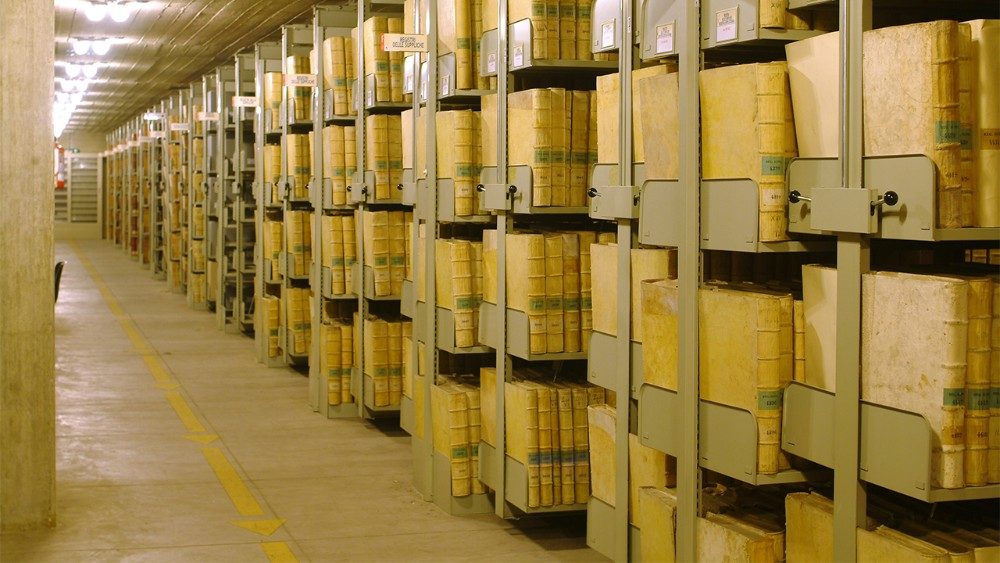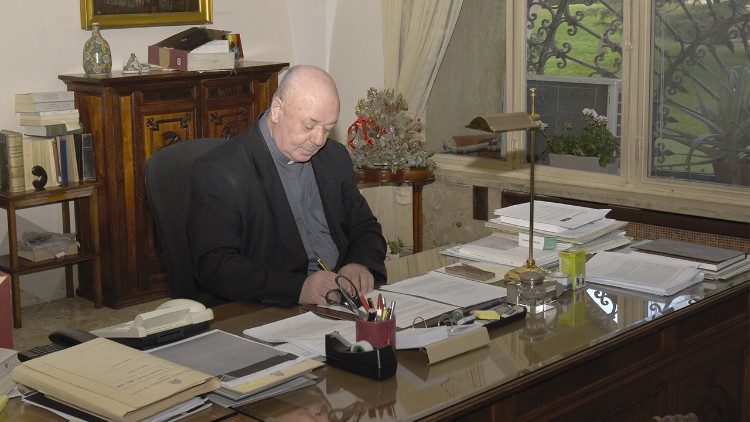The Papal Archives open to the world
Alessandro De Carolis and Benedetta Capelli – Vatican City
It is due to Pope Francis that the Vatican Archives are no longer ‘secret’ but ‘apostolic.’ Substantially nothing about its identity has been lost or changed. In fact, it remains one of the oldest institutions whose mission is clear: to conserve Papal and Curial documents and make them available to those who request them. “The Holy See’s central Archives,” as John Paul II defined it, contains an extension of documentation equaling 85 linear km, making it one of the largest in the world. It is the guardian of thousands of years of history and is not afraid to be open to the public. Proof of this is the possibility to consult documents relating to the pontificate of Pius XII, the Pope who lived the difficult period of Nazism and fascism. The Prefect of the Vatican Apostolic Archives, Bishop Sergio Pagano, says those who use the Archives are not only experts in religious or secular history, but also carry out research that “encompasses every aspect of human society.”
In a secular cultural context like today’s that seems to have lost a sense of memory and a reference to “strong” values, what place does an institution occupy that was founded to conserve historical documents of the papacy and the Church?
The place and the task that the popes have entrusted to what was then called the Vatican Secret Archives, now the Vatican Apostolic Archives, are the same in every age, regardless – generally speaking – of the changing cultural context: that is, to conserve, organize and understand the value of the documentation produced by the secretaries of the Roman Pontiffs and by the various entities making up the Roman Curia, as well as making sure that such documentation be accessible – first of all internally at the service of the Pope and the Holy See, then, from 1881 on, for the direct use of researchers from around the world who use the Vatican Archives to an always increasing extent, for their research.
Notwithstanding “the secular cultural context” to which you refer in your question, from what I know, the number of researchers who request access to the Vatican Archives’ reading rooms has been more or less stable for several decades, that number being around 1,000 requests per year (the number of admission cards went from 1,228 in 2015 to 1,011 in 2018), except this last year during which a number of scholars were stopped from coming to Rome (only 739 admission cards).
The constant interest in the documentation in the Vatican Apostolic Archives (Saint John Paul II confirmed that they are the central archives of the Holy See in the law regarding the archives), has shown no sign of declining over the years, even in, as you have said, a period of strong secularization. This comes from the fact that the documentation of the Pontifical Archives, in addition to a predictable religious aspect, also contains material of a historic, geographic, cultural interest, what scholars call géographie humaine. So, among the scholars conducting research using the documents held in the Apostolic Archives are experts in both religious and secular history. Their research encompasses every aspect of human society. Some research the documents so as to provide documentation for a specific biography (of the popes, emperors, kings or sovereigns and their courts). Others conduct research on a diocese or a city, a state or an empire; others are interested in the broad field of hagiography; others research diplomatic relations; others, religious phenomenon or theological movements; some prefer the history of institutions; others, that of a shrine, or a monastery, or a church; still others are interested in their own parish or country.
After the motu proprio of 22 October 2019 that modified the name, eliminating “secret”, the Vatican Archives together with the Library, both bear the word “Apostolic”. What is the meaning of this decision made by Pope Francis and what meaning does it have for the Archives?
The meaning of the Holy Father’s decision is expressed well in the motu proprio of 22 October 2019 which changed the centuries-old title of the Archivum Secretum Vaticanum, the Vatican Secret Archives, to the Vatican Apostolic Archives. An attentive reading of that document shows that, already back in the 1600s, the papal archives were called both secretum and apostolicum, and that even in the 1800s it was spoken of as the Archivum Secretum Apostolicum Vaticanum. To prevent the easy misinterpretation that the term Segreto in the title was causing, or could cause, in modern languages (including Italian), Pope Francis deemed it appropriate (I think he was right) to remove this term that was by now ‘uncomfortable’ and misleading and to replace it with the term Apostolico, which in practice was equal to Segreto, because in Latin both secretum (which means separate, private) and apostolicum (that is, belonging to the domnus apostolicus, who is only the pope) refer to the same reality, even juridical. The Vatican Apostolic Archives has not lost anything of its original identity by dropping Segreto, because even in the new title Pope Francis gave it, it continues to be the private Archives of the Pope (therefore, Apostolic), subject to him alone and to his exclusive governance.
At first, the change of the title of the Vatican Archives was acknowledged as understandable – a bit nostalgically (the old Latin term secretum contained a hint of intrigue!). Then everyone realized that, in fact, the name change on which the Pope decided responded to and responds to the need to meet modern ‘sensibilities’, since secretum could conjure up hidden mysteries enclosed in obscure and vast vaults, fictionalized only by those who have never known the reality of the Vatican Archives.
How are the personnel and their work organized in the Archives? What are the associated costs? And what are the most relevant items on your specific “mission budget”?
The head of the Vatican Apostolic Archives, as well as the Apostolic Library, is the Cardinal Archivist and Librarian who coordinates the activities of the two institutions and represents them both in the Roman curia and in the international context. The ordinary management of the Vatican Archives belongs to its prefect, appointed by the Pope. The prefect constantly reports on the operation of the institution to the Cardinal Archivist. The vice-prefect, also a papal appointee, always assists the prefect.
It is the prefect’s responsibility to assign the scientific work to the officials and the management of ordinary work to other members of the staff. The latter is composed of archivists, writers, secretaries, assistants, archival staff, specialized lab technicians (IT, photography, bookbinding and restoration), assistants for the three reading rooms and other employees who perform other tasks. All together there are 63 people. This number will be reduced in the span of five years to 58 people due to the need to cut costs. The annual operating costs of the Apostolic Archives are about 2% of the Holy See’s entire budget.
Obviously, the Archive’s most significant budget expense is certainly personnel, although the number of employees working in the Apostolic Archives, which today possesses an extension of documentation equal to approximately 83 linear km, making it one of the largest (and certainly one of the oldest and most precious) in the world, is below actual needs. Other national archives comparable to the Papal Archives have at least double the staff. But it is clear thinking that the Holy See cannot do more than make this economic effort, taking into consideration its relative economic resources and the fact that the considerable expenditure related to the annual maintenance of the Vatican Archives is solely a cultural asset.
Since last year, Pope Francis made the documents of Pope Pius XII’s pontificate available for academic research. Why should the Church not be “afraid of history,” as Pope Francis himself said when he announced the opening of the Pacelli archives?
After a long and necessary period of almost twenty years, on 4 March 2019, Pope Francis announced his decision to open the fundamental documentation of Pius XII’s pontificate (1939-1958) so historians could access it. In so doing, the pontiff reiterated a great truth that had already been revealed by his predecessors (at least from Pope Leo XIII on) – that the Catholic Church has nothing to “fear from history.” The Church well knows that its purpose through the centuries of its existence amidst various societies, persons and cultures, was none other than the salvation of men and women and the construction of the city of God, as willed by its founder, Jesus Christ. The Church knows equally well, that the Lord’s mandate was and is entrusted to other men and women (constituted in the priesthood and in the lay state) in whom, as the entire Old and New Testament teaches, are “mixed” grace and sin, strong faith (holiness) and personal and structural weakness. This is true beginning with Saint Peter, the prince of the Apostles; the same holds true for his successors and the pastors elected to guide the holy people of God. Grace and sin, spiritual sturdiness and human frailty, light and darkness are, after all, undeniably intertwined and reflected in the Church’s history and, therefore, in the documents held in the Pontifical Archives as well. The many, or rather very many, documents from the pontificate of Pope Pius XII also attest to this reality. Yet it is not the cause of the least concern for Pope Francis or for us. Those who will have the patience and intellectual objectiveness to study all of the thousands of papers that have to do with Pius XII and the other entities of the Holy See under his pontificate will have to admit in the end (I am fully convinced of this) that in the extremely murky and dark atmosphere of the Second World War, the See of Peter was by no means eclipsed or clouded by those harsh and terrible times, despite all of the adverse circumstances and uncertainties in which Eugenio Pacelli found himself operating. The opposite is true. The Holy See remained a reference point for humanity and for civilization, for Catholics, non-Catholics and non-Christians, even for those who attacked it or reproached it for all sorts of things.
Thank you for reading our article. You can keep up-to-date by subscribing to our daily newsletter. Just click here










